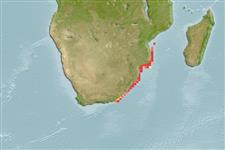Elasmobranchii (Haie und Rochen) (sharks and rays) >
Torpediniformes (Electric rays) >
Narkidae (Sleeper rays)
Etymology: Heteronarce: Greek, heteros = other + Greek, narke = numbness (Ref. 45335).
More on author: Regan.
Environment: milieu / climate zone / depth range / distribution range
Ökologie
seewasser demersal; tiefenbereich 73 - 329 m (Ref. 6589). Subtropical; 20°S - 35°S, 27°E - 37°E (Ref. 114953)
Western Indian Ocean: southern Mozambique to Algoa Bay, South Africa (Ref. 5578).
Size / Gewicht / Alter
Maturity: Lm ? range ? - ? cm
Max length : 25.0 cm TL Männchen/unbestimmt; (Ref. 6589)
Kurzbeschreibung
Morphologie | Morphometrie
Small ray with an elongated, narrow disc and a small, narrow caudal fin (Ref. 5578). Plain brown above, white below (Ref. 5578).
Found on the outer shelf and upper slope (Ref. 5578). Life history unknown. Males reaches maturity at ca. 17 cm TL (Ref. 114953).
Life cycle and mating behavior
Geschlechtsreife | Fortpflanzung | Ablaichen | Eier | Fecundity | Larven
Compagno, L.J.V., 1986. Narkidae. p. 113-114. In M.M. Smith and P.C. Heemstra (eds.) Smiths' sea fishes. Springer-Verlag, Berlin. (Ref. 6589)
IUCN Rote Liste Status (Ref. 130435)
Bedrohung für Menschen
Other
Nutzung durch Menschen
Fischereien: nicht kommerziell
Mehr Information
Alter/GrößeWachstumLänge-GewichtLänge-LängeLängenhäufigkeitenMorphometrieMorphologieLarvenLarven Pop.Dyn.RekrutierungDichteBRUVS
ReferenzenAquakulturAquakultur ProfilZuchtlinienGenetikElectrophoresesVererbbarkeitKrankheitenVerarbeitungNutrientsMass conversion
PartnerBilderStamps, Coins Misc.LauteCiguateraGeschwindigkeitSchwimmstilKiemenoberflächeOtolithsGehirngrößeSehfähigkeit
Tools
Zusatzinformationen
Download XML
Internet Quellen
Estimates based on models
Preferred temperature (Ref.
123201): 15.2 - 22, mean 18.1 °C (based on 27 cells).
Phylogenetic diversity index (Ref.
82804): PD
50 = 0.5627 [Uniqueness, from 0.5 = low to 2.0 = high].
Bayesian length-weight: a=0.01000 (0.00244 - 0.04107), b=3.04 (2.81 - 3.27), in cm total length, based on all LWR estimates for this body shape (Ref.
93245).
Trophic level (Ref.
69278): 3.2 ±0.3 se; based on size and trophs of closest relatives
Widerstandsfähigkeit (Ref.
120179): niedrig, Verdopplung der Population dauert 4,5 - 14 Jahre. (Assuming fecundity<100).
Fishing Vulnerability (Ref.
59153): Low vulnerability (15 of 100).
